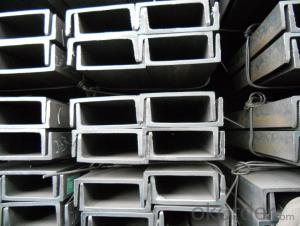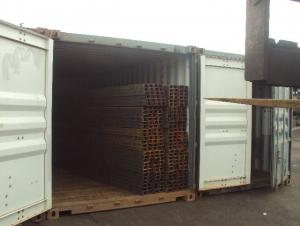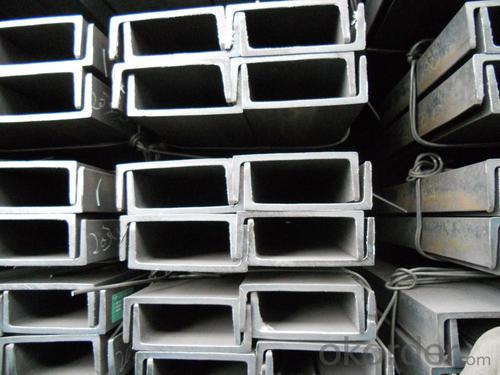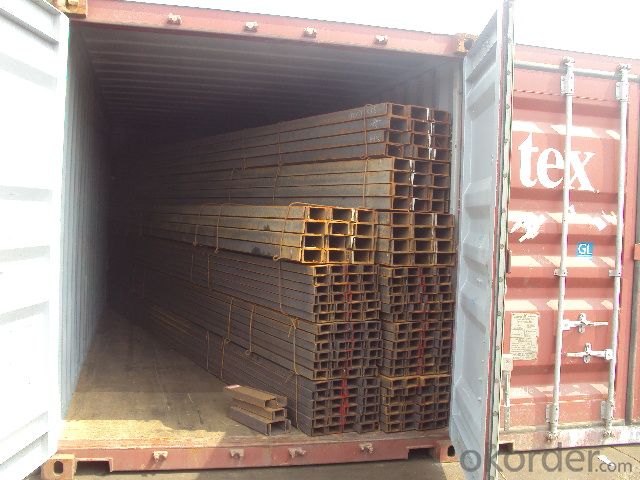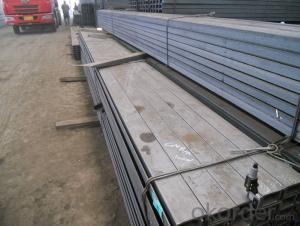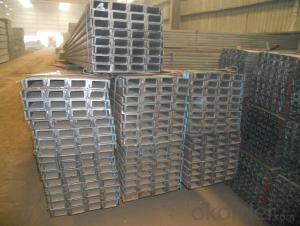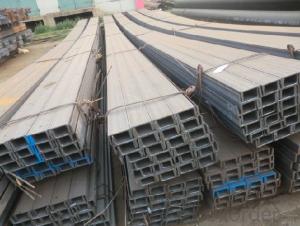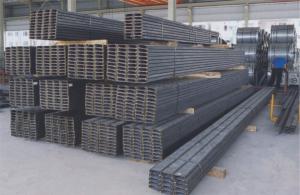U-channel Carbon Steel JIS Standard Many Sizes Hot Rolled
- Loading Port:
- Tianjin
- Payment Terms:
- TT OR LC
- Min Order Qty:
- 25 m.t.
- Supply Capability:
- 2000 m.t./month
OKorder Service Pledge
OKorder Financial Service
You Might Also Like
Product Description:
OKorder is offering U-channel at great prices with worldwide shipping. Our supplier is a world-class manufacturer of steel, with our products utilized the world over. OKorder annually supplies products to European, North American and Asian markets. We provide quotations within 24 hours of receiving an inquiry and guarantee competitive prices.
Product Applications:
1.The JIS channel can be devided into two kinds, namely common channel steel and light channel steel. The sizes of hot rolled common channel steel range from 5# to 40#. Meanwhile, the channel steel can be divided into cold forming sectional equal channel steel, cold forming sectional unequal channel steel, cold forming inner edge channel steel and outer edge channel steel.
2.The JIS channel is usually used for arch-itechtural structure, and they could be welded in order to support or hang a vari-ety of facilities. They are also usually used in combination with I beam. The channel steel with sizes under 14# is usually applied to construction engineering, as purline, while the channel steel with sizes above 16# is more likely to be used in building vehicle chassis structure and mechanical structure. Furthermore, the channel steel in sizes above 30# are target at building bridge structure, as tension bar.
Product Advantages:
OKorder's U-channel are durable, strong, and resist corrosion.
Main Product Features:
· Premium quality
· Prompt delivery & seaworthy packing (30 days after receiving deposit)
· Corrosion resistance
· Can be recycled and reused
· Mill test certification
· Professional Service
· Competitive pricing
Product Specifications:
1.We are able to provide channel steel of top quality at attractive price.
2.Our products of channel steel have passed ISO9001:2008 Quality Management System Certification.
Alloy No | Grade | Element (%) | |||||
C | Mn | S | P | Si | |||
Q235 | B | 0.12—0.20 | 0.3—0.7 | ≤0.045 | ≤0.045 | ≤0.3 | |
Alloy No | Grade | Yielding strength point( Mpa) | |||||
Thickness (mm) | |||||||
≤16 | >16--40 | >40--60 | >60--100 | ||||
≥ | |||||||
Q235 | B | 235 | 225 | 215 | 205 | ||
Alloy No | Grade | Tensile strength (Mpa) | Elongation after fracture (%) | ||||
Thickness (mm) | |||||||
≤16 | >16--40 | >40--60 | >60--100 | ||||
≥ | |||||||
Q235 | B | 375--500 | 26 | 25 | 24 | 23 | |
Note of U-channel
1. According to national standard (GB) for our products, if not, supply according to national standards (GB) or agreement.
2. We can not only provide electric furnace +LF+VD and electros lag re-melting (ESR) steel forging materials, but also forging products of piece, bar, etc.
3. Our company is equipped with roll equipment and can provide our customers with roll billets or finished.
4. The materials that we purchase are all accord with International General Standard; you could check it out on the Material Quality Sheet.
5. We are the creator of the “seven-step inspect method” in China.
6. The technical workers we employed are the ones with many years’ working experience, who know the technology procedures very well.
FAQ:
Q1: Why buy Materials & Equipment from OKorder.com?
A1: All products offered byOKorder.com are carefully selected from China's most reliable manufacturing enterprises. Through its ISO certifications, OKorder.com adheres to the highest standards and a commitment to supply chain safety and customer satisfaction.
Q2: How do we guarantee the quality of our products?
A2: We have established an advanced quality management system which conducts strict quality tests at every step, from raw materials to the final product. At the same time, we provide extensive follow-up service assurances as required.
Q3: How soon can we receive the product after purchase?
A3: Within three days of placing an order, we will begin production. The specific shipping date is dependent upon international and government factors, but is typically 7 to 10 workdays.
Images:
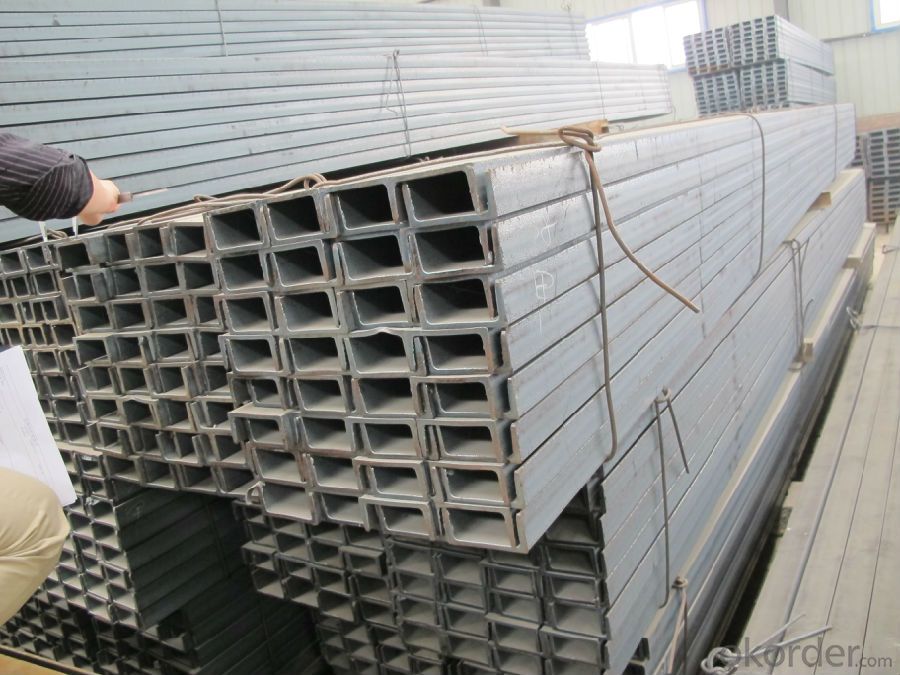

- Q: In the construction engineering construction site, such as channel material piled reinforced why mat wood, directly on the concrete floor (ground) on the surface is not?
- The steel placed timbers on or on the platform, it can be reinforced to prevent contact with moisture rust, but also can keep clean to prevent contamination of reinforced soil.
- Q: How do steel channels contribute to the overall structural integrity of a building?
- The utilization of steel channels plays a pivotal role in augmenting the overall structural soundness of a building. These essential structural constituents are frequently employed in construction projects due to their exceptional robustness, endurance, and adaptability. Generally, steel channels are fashioned into C-shaped or U-shaped beams using steel, which confers numerous advantages for the structural stability of a building. Primarily, steel channels proficiently distribute and convey loads. As a result of their configuration, steel channels are adept at supporting heavy loads and evenly dispersing them across multiple points. This equitable allocation of weight obviates the occurrence of concentrated stress points, thereby mitigating the risk of structural failure. Additionally, steel channels possess a high load-bearing capacity, enabling them to endure substantial forces and guarantee the overall steadiness of the building. Secondarily, steel channels offer resistance against bending and torsion forces. Their shape and material composition empower them to resist deformation under pressure, guaranteeing that the building maintains its structural integrity even under extreme conditions such as earthquakes or strong winds. By averting excessive deflection, steel channels aid in maintaining the safety and security of the building. Moreover, steel channels boost the rigidity and stability of the structure. By connecting various components of the building, such as beams, columns, and walls, steel channels effectively eliminate any potential weak points or gaps. This comprehensive integration of different elements contributes to the overall strength and stability of the building, precluding any potential structural failures. Lastly, steel channels provide flexibility in design and construction. They can be easily customized to suit specific architectural requirements, allowing for innovative and efficient building designs. The versatility of steel channels empowers architects and engineers to optimize the strength and stability of the structure while preserving aesthetic appeal. In conclusion, steel channels play a significant role in bolstering the overall structural integrity of a building by efficiently distributing and conveying loads, resisting bending and torsion forces, enhancing rigidity and stability, and providing design flexibility. Their strength, durability, and versatility render them an indispensable component in contemporary construction, ensuring the safety and longevity of buildings.
- Q: Is the channel 20 the same as the channel 20b?
- In use, it requires better welding, riveting performance and comprehensive mechanical properties. The raw material steel billet for channel steel is carbon or low alloy steel billets with a carbon content of not more than 0.25%. The finished channel steel is delivered by hot forming, normalizing or hot rolling.
- Q: What are the advantages of using steel channels over other materials?
- There are several advantages of using steel channels over other materials: 1. Strength and Durability: Steel channels are known for their high strength and durability. They can withstand heavy loads and provide structural stability, making them suitable for various applications in construction and engineering. 2. Versatility: Steel channels can be easily shaped and manipulated to fit specific requirements. They can be cut, welded, and bent into different shapes and sizes, allowing for flexibility in design and construction projects. 3. Cost-Effective: Steel channels are a cost-effective choice compared to other materials like aluminum or wood. They require minimal maintenance, have a longer lifespan, and can be recycled, reducing the overall costs associated with construction and maintenance. 4. Fire Resistance: Steel channels have inherent fire resistance properties, making them a safer choice in building structures. They do not contribute to the spread of fire and provide additional time for evacuation in case of emergencies. 5. Sustainability: Steel is a highly sustainable material as it can be recycled indefinitely without losing its properties. Choosing steel channels over other materials promotes environmental conservation and reduces the carbon footprint associated with construction projects. 6. Resistance to Corrosion: Steel channels can be treated with coatings or galvanized to enhance their resistance to corrosion. This makes them suitable for outdoor applications where they might be exposed to moisture, humidity, or other corrosive elements. 7. Structural Integrity: Steel channels provide excellent structural integrity, ensuring that the components they support remain stable and secure. This is particularly important in applications where safety and load-bearing capacity are crucial, such as bridges, high-rise buildings, or industrial structures. In summary, the advantages of using steel channels over other materials include their strength, durability, versatility, cost-effectiveness, fire resistance, sustainability, resistance to corrosion, and ability to maintain structural integrity. These benefits make steel channels a preferred choice for various construction and engineering projects.
- Q: What are the different types of loads that steel channels can bear?
- Steel channels are versatile structural components that can bear various types of loads. The different types of loads that steel channels can bear include: 1. Compression Load: Steel channels have a high load-bearing capacity and can withstand compression forces. They are commonly used in columns and beams to support the weight of a structure or transfer loads vertically. 2. Tension Load: Steel channels are also capable of bearing tension loads. They can resist forces that tend to pull or stretch the material, making them suitable for applications such as trusses or suspension systems. 3. Shear Load: Steel channels can withstand shear forces, which occur when two forces act parallel to each other but in opposite directions. They are commonly used in structural systems to resist the shearing effects of horizontal loads, such as wind or seismic forces. 4. Bending Load: Steel channels can bear bending loads, which occur when a force is applied perpendicular to the axis of the channel. They are often used as beams or lintels to support loads over openings like doors or windows. 5. Axial Load: Steel channels are designed to bear axial loads, which act along the longitudinal axis of the channel. These loads can be compressive or tensile and are typically encountered in columns or vertical members. 6. Lateral Load: Steel channels can also bear lateral loads, which act perpendicular to the longitudinal axis of the channel. These loads can arise from wind, earthquakes, or other horizontal forces and are resisted by the structural system where the channel is incorporated. Overall, steel channels are a versatile choice for structural applications due to their ability to bear various types of loads. Their strength, durability, and flexibility make them suitable for a wide range of construction and engineering projects.
- Q: What are the different types of connections used for steel channels in roof trusses?
- There are several different types of connections that can be used for steel channels in roof trusses. Some of the most common types include: 1. Welded connections: This involves welding the steel channel directly to the other components of the roof truss, such as gusset plates or other steel members. Welded connections provide a strong and rigid connection, but they require skilled labor and can be time-consuming. 2. Bolted connections: Bolts are used to connect the steel channel to other components of the roof truss. This type of connection is easier to install compared to welding and can be disassembled if needed. It provides a strong connection, but there is a risk of bolts loosening over time and requiring regular maintenance. 3. Pinned connections: In this type of connection, a pin or a bolt is used to connect the steel channel to other components of the roof truss. Pinned connections allow for rotational movement, which can be advantageous in certain applications but may require additional support to prevent excessive movement. 4. Cleat connections: Cleats are flat plates that are bolted or welded to the steel channel and other components of the roof truss. This type of connection is commonly used for connecting purlins or rafters to the steel channel. Cleat connections provide good load transfer and are relatively easy to install. 5. Gusset plate connections: Gusset plates are typically used in conjunction with bolted or welded connections to provide additional strength and rigidity. These plates are usually made of steel and are bolted or welded to the steel channel and other components of the roof truss. The choice of connection type depends on various factors such as the structural requirements, load capacity, ease of installation, and maintenance considerations. It is essential to consult with a structural engineer or a professional with expertise in roof truss design to determine the most suitable connection type for a specific application.
- Q: Channel 10, 6 meters long, two ends fixed, how much weight can the middle bear?
- It's important to see where you've used it. If you allow it to bend, you'll have to bear a lot of weight, but vice versa
- Q: Installation of floor type distribution box, foundation channel production and installation, the quota should choose which two?
- Floor type distribution box installation cannot apply the distribution cabinet installation, and should set floor type of distribution box installation quota; installation set foundation channel steel foundation channel steel installation item.The foundation channel steel production: the foundation channel steel is not installed item containing material, quantity of steel plate, galvanized flat steel, round steel is installed base grounding of the auxiliary channel and. To calculate the foundation channel steel production, making composite iron production, the quantity of round bar, angle steel, flat steel can be unified to channel.
- Q: What are the considerations for steel channel bracing?
- When contemplating steel channel bracing, there are several crucial factors that need to be taken into consideration. To begin with, it is of utmost importance to assess the structural requirements of the building or structure that the bracing will be supporting. This entails evaluating the loads and forces that will be exerted on the bracing system, as well as understanding the specific design codes and standards that must be adhered to. Ensuring that the bracing system can endure the expected loads and provide the required stability to the structure is absolutely essential. Secondly, careful consideration must be given to the material properties of the steel channel used for bracing. This involves evaluating the strength, stiffness, and ductility of the steel channel. Selecting a steel channel with the appropriate properties to withstand the loads and forces imposed on the bracing system is of great importance. Additionally, factors like corrosion resistance and fire resistance should also be taken into account. Another factor to consider is the design and layout of the bracing system. The spacing and arrangement of the steel channel braces should be meticulously planned to ensure sufficient support and stability. The bracing system should be designed in a manner that effectively distributes the loads and minimizes the potential for buckling or instability. Furthermore, the connections between the steel channel braces and the supporting structure should be strong and capable of efficiently transferring the loads. In addition to the design and layout, the installation of the steel channel bracing is a crucial aspect to consider. Proper installation techniques must be followed to ensure correct and secure installation of the bracing system. This involves using suitable fasteners and ensuring that the bracing is aligned and connected properly. Lastly, it is important to take into account any potential limitations or restrictions that may impact the steel channel bracing. This could include factors such as available space for installation, access for maintenance or repair, or any specific environmental conditions that could affect the performance of the bracing system. Overall, by carefully considering the structural requirements, material properties, design and layout, installation techniques, and any limitations or restrictions, one can ensure that the steel channel bracing is effective and provides the necessary support and stability for the structure.
- Q: How do steel channels perform under impact loads?
- Steel channels are known to have excellent performance under impact loads. Due to their structural design and material properties, steel channels are able to effectively absorb and distribute the impact energy, thus minimizing the potential for damage or failure. The structural shape of steel channels, with their flanges and web, provides increased stiffness and rigidity, which enhances their ability to withstand impact loads. Additionally, the use of high-strength steel in the manufacturing of steel channels further enhances their impact resistance capabilities. This allows steel channels to effectively resist deformation and maintain their structural integrity even when subjected to significant impact forces. Overall, steel channels are a reliable choice for applications where impact loads are a concern, providing a high level of performance and ensuring the safety and durability of structures or systems.
Send your message to us
U-channel Carbon Steel JIS Standard Many Sizes Hot Rolled
- Loading Port:
- Tianjin
- Payment Terms:
- TT OR LC
- Min Order Qty:
- 25 m.t.
- Supply Capability:
- 2000 m.t./month
OKorder Service Pledge
OKorder Financial Service
Similar products
Hot products
Hot Searches
Related keywords
